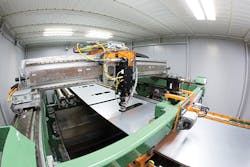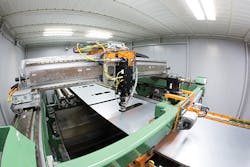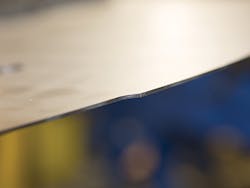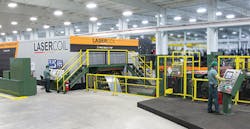Process meets challenges of advanced materials, complex shapes, and delivery
JAY FINN
Use of lasers for cutting blanks has proven to be a feasible technology for cutting shapes from stationary, sheared, rectangular-shaped blanks. But limitations in cutting speeds, coupled with challenges in finding efficient ways to integrate the technology into a mass production line for developed blanks, have hindered laser cutting for high-volume applications. Until recently, available solutions for applying lasers to sheet metal blanking typically incorporated robots (loading/unloading tables and destacking systems) to present an automated solution, essentially adding steps to the process. As such, laser cutting approaches were used only for prototype and very low-volume production of complex-shaped sheet metal blanks.
Recent advances in laser technology and increases in cutting speeds have now opened opportunity for development of new and viable laser blanking solutions suited to higher production volumes. As an automotive supplier of high-speed coil processing equipment and automated systems, Automatic Feed Company (Napoleon, OH) saw the advantages to be gained by laser blanking directly from coil stock. With a product portfolio that included servo shears and high-speed stacking equipment, developing a way to integrate lasers into their production lines seemed to be a natural business development strategy. In the mid-2000s, the company invested in developing a laser cutting solution that could cut directly from coil-fed stock, with a goal to overcome the traditional barriers faced when attempting to replace stamping presses and shears with lasers. After five years of research and development that produced working prototypes capable of running production, LaserCoil Technologies LLC was spun off in 2011 to take the patented technologies to market.
LaserCoil Technologies first introduced its coil laser blanking system to the market in 2014 after having successfully run production on a prototype line since 2012. LaserCoil's system has many patented features that have led to successful applications in production environments. This process relies on a series of dynamic profile conveyors that support the coil strip while providing a cutting path for the laser heads. These lanes independently and dynamically reposition to maintain a clear path below the moving laser head. This allows the coil to move forward through the system without jogging the strip back and forth and also automatically shedding scrap during the cutting process, delivering a burr-free, ready-to-stack part.
The laser cutting heads, using linear-induction motors, enable cutting of tightly nested, complex curvilinear shapes. These high-speed, three-axis linear motor gantry-mounted laser heads (FIGURE 1) can be stationed in multiple modular cutting cells that travel along the moving strip to balance the workload for improved throughput, achieving rates similar to conventional blanking methods.
Importantly, from a capital investment standpoint, LaserCoil systems are flexible and can integrate with any coil line automation, as well as be retrofit into aging blanking press lines.
LaserCoil's original system featured a single head and a 4kW fiber laser that moved material forward in a feed index mode, enabling higher yield rates and producing small parts as quickly as 32ppm and larger body-size type panels at up to 18ppm for production runs of up to 30,000. Since then, LaserCoil has continued to invest in R&D with its most recent system featuring multiple heads and 6kW lasers, significantly increasing the speed of part processing.
The technology can process materials 0.5–3.5mm thick and coils up to 2.1m wide. The original single-head system cut 1.0mm-thick materials at a straight-line rate of 2.5m/s. But adding another laser head enables shared balancing of the cutting workload to decrease processing time and improve productivity. The multiple-head LaserCoil machines can improve production rates by an average of 85% compared to a single head, making it well suited for production runs of up to 100,000.
Another major development has been the ability for LaserCoil systems to run either in stop/start (feed index) or continuous mode. This allows users to optimize the cutting parameters dependent upon the particular part configuration. For example, large, complicated parts or cuts that require tight edge tolerance will likely run better in feed index mode.
Laser cutting addresses today's trends
The focus on lightweighting in automotive has heralded the entry of new materials and metal grades into the market. This has led to the increasing use of advanced high-strength steels (AHSS) with tensile strengths of 750MPa and above. Forecasts say that AHSS will comprise 40% of vehicle content on body and closures by 2025.
As compared to other lightweight materials, AHSS enables car makers to decrease vehicle weight, while also meeting today's higher crash standards. However, these materials often cause difficulties with existing manufacturing processes.
For example, although AHSS can be stamped on traditional mechanical presses, it typically requires larger tonnage, which can adversely impact tooling—breaking dies or even the press. With limits to the maximum tonnage you can get from a press, it's possible that high-strength steels may cause the blanking operation be moved to a larger-capacity press to achieve the same cut. This results in a higher production rate and significantly higher maintenance costs for the cutting tool, as the blades will dull at an increased rate.
Moreover, as the hardness of the steel material increases, so does the propensity of microfractures occurring along the cut edges of the blank during the mechanical blanking operation. These microfractures can develop into splits issues during the forming process.
With LaserCoil's approach, there are no microfractures produced when compared to the shearing or punching mechanical process (FIGURE 2). It minimizes the hardness change on the edge of the cut, and the dross is significantly less than a standard burr from mechanical cutting. Quite often, the dross is non-existent on light-gauge materials. This high level of quality improves forming, as it is more resistant to tearing and allows laser welding directly to the cut edge.
Laser cutting also provides flexibility for quick changeover, enabling quick reaction to automotive volume variations (FIGURE 3). The traditional stamping process requires extensive die production time, taking six months to a year to develop the original forming die sets. Add to this tryout and modification time, as well as 14–16 weeks to produce the final blanking die after tryout is completed—the process becomes lengthy and expensive.
Lasers eliminate dedicated tooling, as material can be ordered and programming accomplished in less than a day—sometimes in just a couple of hours. With hard tooling, there is a significant undertaking to make even the smallest of changes. With laser cutting, the program can be modified with a simple 2D CAD software program. Costly changes that would take days to implement can be made for virtually no cost and in five minutes.
Put to the test
Since 2014, Precision Strip has successfully produced tens of thousands of coil-fed laser blanks out of its Perrysburg, OH facility utilizing the Laser Coil equipment, processing blanks for automotive production applications, small runs for prototypes and blank engineering changes, and service part requirements (FIGURE 4). "All the blanks produced have met all the customer requirements when it comes to consistent blank geometry, cut edge quality, and blank cleanliness," says Don Tomasek, director of sales and marketing at Precision Strip. "As we continue to develop and optimize this new technology, Precision Strip is excited about the flexibility and different options that we can offer to our existing and future customers."
So, is laser blanking a solution for you? With these developments, laser cutting from coil is not only for niche production anymore—it can be considered a viable production alternative for any situation, having proven its ability to run production into the 100,000-piece range. But it is especially well suited for dealing with the challenges of advanced materials, complex shapes, and delivery issues, making it an excellent choice for today's industry challenges.
JAY FINN([email protected]) is the general manager/CTO at LaserCoil Technologies LLC, Napoleon, OH; www.lasercoil.com.




